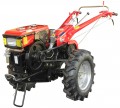The type of gearbox provided in the design of the two-wheel tractor.
The gearbox is a mechanism for transmitting rotation from the motor shaft to the working shaft; the speed of rotation is reduced, and the tractive effort, respectively, increases. In modern units,
worm,
chain,
gear and
gear-chain gearboxes can be used; here are their main features:
— Worm. Gearboxes based on a worm gear are mainly used in light two-wheel tractors with passive cutters (motor cultivators). With simplicity and low cost, such a gearbox provides a high gear ratio, which makes it possible to achieve good traction at a relatively low engine power. Other advantages of worm gears include compactness, minimum noise level, smooth running and self-braking ability. On the other hand, such gearboxes do not tolerate high loads, which determined the scope of their application.
— Chain. Gearboxes based on a chain drive — two gears connected by a chain (similar to the mechanism used in bicycles). Such gearboxes are somewhat more expensive than worm gears, but they are more reliable and able to work with higher loads. Another advantage lies in the small width of the body, which is especially important for motor cultivators — the gearbox does not limit the depth of processing, since it can be buried in the soil simultaneously with the cutters.
...— Geared. The most advanced type of modern gearboxes. Such mechanisms are highly reliable and durable, they normally endure long-term work at high loads. The downside of these advantages is the high price. Gear reducers are used mainly on professional equipment, for which "endurance" is critical.
— Gear-chain. A compromise option, which, when installed on a motor cultivator, increases its performance (compared to chain and worm), and when installed on a motor block, slightly reduces the cost of the latter.The method of starting a petrol or diesel engine (see "Motor type") provided in the unit.
— Manual. Starting by human muscle power: the operator pulls a special cable or turns a handle, which causes the shaft to rotate and the engine to receive the initial impulse necessary for operation. Manual starting systems are inexpensive, lightweight and compact, and do not depend on batteries that can run out at the most inopportune moment. On the other hand, the starting process itself may require significant effort, especially in a heavy, powerful engine. Therefore, this option is used mainly in relatively low-power models.
—
Electric . Starting with starter — small electric motor powered by a battery. Such systems are much more convenient than manual ones — the operator is actually required to press a button or turn a key; they are suitable even for the most powerful motors. On the other hand, a starter with a battery significantly increases the weight, dimensions and cost of the entire unit, and if left idle for a long time, the battery may run down, and the system will become useless (however, a spare manual "starter" may be provided for this case). Therefore, this starting method is used exclusively in heavy equipment, for which the ability to do without manual starting is more important than the described disadvantages.

